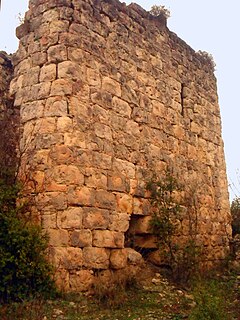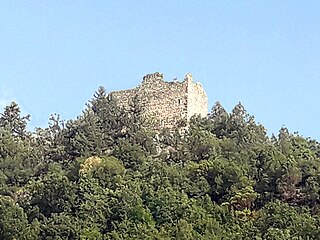
Cilicia is a geographical region in southern Anatolia in Turkey, extending inland from the northeastern coasts of the Mediterranean Sea. Cilicia has a population ranging over six million, concentrated mostly at the Cilicia plain. The region includes the provinces of Mersin, Adana, Osmaniye, along with parts of Hatay and Antalya.

The Cilician Gates or Gülek Pass is a pass through the Taurus Mountains connecting the low plains of Cilicia to the Anatolian Plateau, by way of the narrow gorge of the Gökoluk River. Its highest elevation is about 1000m.

Tarsus is a historic city in south-central Turkey, 20 km inland from the Mediterranean. It is part of the Adana-Mersin metropolitan area, the fourth-largest metropolitan area in Turkey with a population of 3 million people. Tarsus forms an administrative district in the eastern part of the Mersin Province and lies in the core of Çukurova region.

Corycus was an ancient city in Cilicia Trachaea, Anatolia, located at the mouth of the valley called Şeytan deresi; the site is now occupied by the town of Kızkalesi, Mersin Province, Turkey.
Lampron is a castle near the town of Çamlıyayla in Mersin Province, Turkey. While part of the Armenian Kingdom of Cilicia in the Middle Ages, the castle was known as Lampron and was the ancestral home of the Armenian Hethumid princes. Situated in the Taurus Mountains, the fortress guarded passes to Tarsus and the Cilician Gates.

Çukurova or the Cilician Plain, is a large fertile plain in the Cilicia region of southern Turkey. The plain covers the easternmost areas of Mersin Province, southern and central Adana Province, western Osmaniye Province and northwestern Hatay Province.
The Belen Pass, known in antiquity as the Syrian Gates, is a pass through the Nur Mountains located in the Belen District of Hatay Province in south-central Turkey.

Yılankale is a late 12th–13th century Armenian castle in Adana Province of Turkey. It is known in Armenian as Levonkla after its possible founder—King Leo (Levon) I the Magnificent of the Armenian Kingdom of Cilicia. Medieval Armenian names attached to the site are Kovara and Vaner.
Gülek is a town in Mersin Province, Turkey.

Limonlu is a small town in Mersin Province, Turkey.
Güveloğlu is a village in the District of Yüreğir, Adana Province, Turkey.

The Casemates of Ibrahim Pasha, are a number of casemates built by Ibrahim Pasha of Egypt in 1833 to the north of Gülek Pass in southern Turkey.

Çandır Castle the medieval Armenian site of Paperon, is a fortification in Mersin Province, Turkey.

Sinap Castle is a medieval Armenian fortification in Çamlıyayla ilçe (district) of Mersin Province in southern Turkey.

Kızkalesi is an island castle situated on a small island in Mersin Province of Turkey.

Yaka Castle is a castle ruin in Mersin Province, Turkey. Although its name is Güdübeş, it is popularly known as Yaka referring to a former village to the east of the castle.
Durak railway station is a railway station in the Mersin Province of Turkey. Since the station is not near any settlement, it is used mainly as a siding. Durak station was originally opened on 27 April 1912 by the Baghdad Railway. Sitting at the base of the Taurus Mountains, the station was used as a staging point to construct the railway further through the mountains, similar to Ulukışla station. The station house was built in the Turkish Neoclassical style, similar to the Yenice station house.

Kuzucubelen Castle is a castle ruin in Mersin Province, Turkey.

Evciler Castle, also called as Kızılbağ Castle, and Evcili Castle is a small medieval castle in Mersin Province, Turkey.

Cilicia was one of the most important regions of the Middle East throughout history, who hosted the Hittite, Hellenistic, Roman, Armenian, and Islamic civilizations. Historically many people considered it as a part of the Levant, and during what is called the Rashidun Caliphate, much of its area was titled with the arabic name "Ath-Thugur As-Shamiyya"-carrying the meaning Levantine outskirts.





















